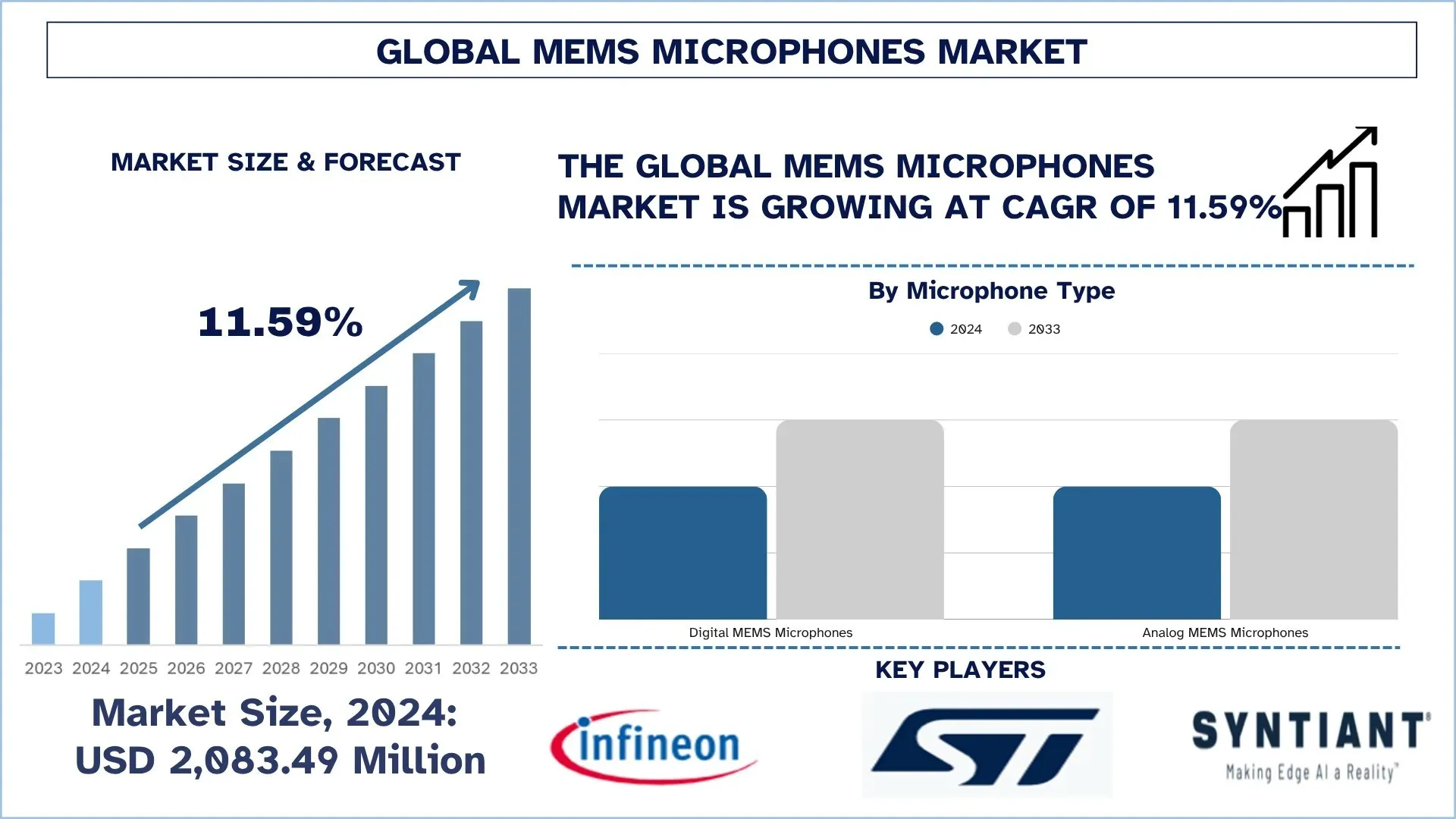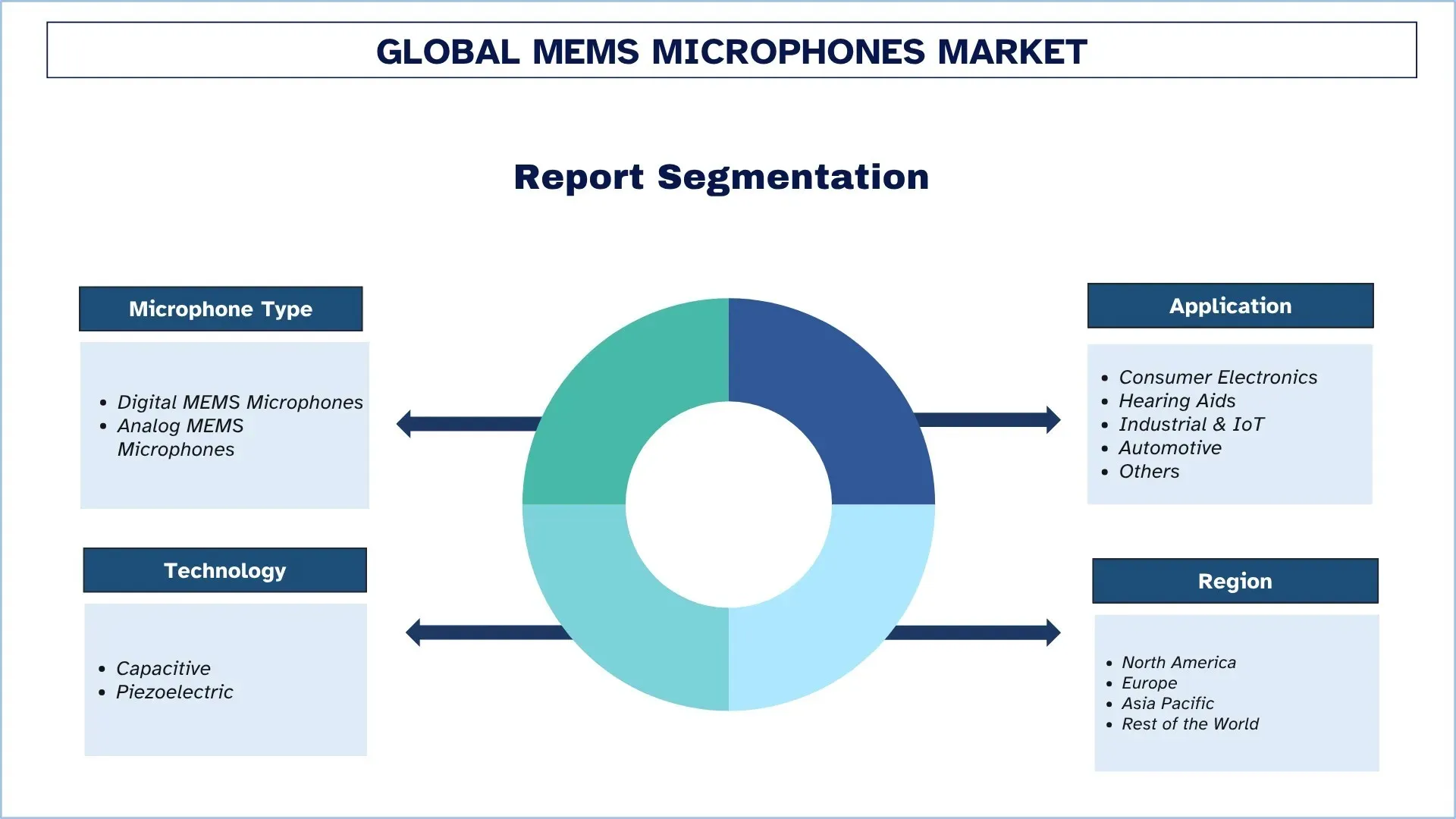- Home
- About Us
- Industry
- Services
- Reading
- Contact Us
MEMS Microphones Market: Current Analysis and Forecast (2025-2033)
Emphasis on Microphone Type (Digital MEMS Microphones and Analog MEMS Microphones); Technology (Capacitive and Piezoelectric); Application (Consumer Electronics, Hearing Aids, Industrial & IoT, Automotive, and Others); and Region/Country

Global MEMS Microphones Market Size & Forecast
The global MEMS microphones market was valued at USD 2,083.49 million in 2024 and is expected to grow at a strong CAGR of around 11.59% during the forecast period (2025-2033F), driven by rising demand for smart consumer electronics, automotive voice-enabled systems, wearable devices, and advancements in miniaturized, low-power audio sensors.
MEMS Microphones Market Analysis
MEMS (Micro-Electro-Mechanical Systems) microphones are small silicon-based devices that convert audio signals into electrical signals using capacitive sensors or piezoelectric technology. They consist of a pressure-sensitive diaphragm etched into a silicon chip and an integrated preamplifier that improves the output signal. Their digital output and compatibility with modern electronics make them suitable for applications that require voice recognition, noise cancellation, and hands-free communication. The global MEMS microphones market is showing robust growth due to increasing demand for smart and compact components in consumer electronics, automotive, and healthcare sectors. In the healthcare sector, MEMS microphones are largely used in hearing and diagnostic devices because of their small size, low power usage, and high sound sensitivity. Growing awareness of improved audio performance in assistive hearing technologies, along with advancements in biocompatible materials and sensor integration, is further fueling demand. Furthermore, increasing innovation in wearable medical devices and government investments in healthcare are further boosting market growth.

Global MEMS Microphones Market Trends
This section discusses the key market trends that are influencing the various segments of the global MEMS microphones market, as found by our team of research experts.
Rising Innovation in the Healthcare Sector
Rising innovation in the healthcare sector is one of the key trends in the MEMS microphones market. These microphones are widely used in hearing aids, diagnostic devices, telemedicine equipment, and wearable devices due to their small size, low power use, and high performance. Advances such as miniaturized devices, wireless monitoring systems, AI-assisted diagnostics, and telehealth solutions are boosting demand for microphones that can capture precise audio signals in different environments. For example, in 2023, Starkey introduced the Genesis AI hearing aid. The device utilizes a Neuro Processor and Deep Neuron Network (DNN) accelerators to analyze sound and make over 80 million adjustments every hour to enhance speech and reduce noise, mimicking the brain's processes of sound. In hearing aids, MEMS microphones are used to improve sound quality and speech clarity. Additionally, MEMS microphones are important in telemedicine platforms, allowing clear audio communication between patients and healthcare providers. The rising demand for customized healthcare, continuous monitoring, and portable medical solutions encourages manufacturers to develop highly sensitive and low-noise MEMS microphones, thereby driving the growth of the market.
MEMS Microphones Industry Segmentation
This section provides an analysis of the key trends in each segment of the global MEMS microphones market report, along with forecasts at the global, regional, and country levels for 2025-2033.
The Digital MEMS Microphones Market Dominates the Global MEMS Microphones Market
Based on the microphone type category, the market is categorized into digital MEMS microphones and analog MEMS microphones. The digital MEMS microphones market holds the largest market share due to their high noise cancellation power, system integration, and compatibility with modern circuits. Digital microphones don't need analog-to-digital conversion components; they directly generate output in a digital signal, offering clear sound quality, lower interference, and simplified design. Additionally, they support multi-microphone arrays and audio features like beamforming and voice recognition, thereby strengthening their position in the market. However, the analog MEMS microphones Market is growing rapidly due to its low power usage, smaller form factor, and affordability.
The Capacitive Segment Dominates the Global MEMS Microphones Market.
Based on the technology category, the market is categorized into capacitive and piezoelectric. Among these, the capacitive MEMS microphone segment leads the market because of its high signal-to-noise ratio (SNR) and low distortion. These microphones are mainly used in smartphones, laptops, and smart wearables due to their excellent sound quality. However, the piezoelectric MEMS microphone sector is experiencing the fastest growth because of its durability, low power consumption, and the quality that it does not require an additional power source. These features make them highly suitable for evolving applications in IoT devices, industrial sensors, and outdoor electronics. Moreover, the growing demand for durable, low-power audio solutions is driving the demand for piezoelectric technology in the market.
North America holds the largest market share in the global MEMS microphones market
North America holds the largest market share in the global MEMS microphones market due to early adoption of advanced technologies, well-established manufacturing, and consumer electronics infrastructure, along with the presence of advanced R&D institutes. North America is a hub of major smartphone, wearable, and semiconductor manufacturing companies, such as Apple, Qualcomm, and STMicroelectronics, which sustain strong R&D coupled with continuous collaboration for developing new products, further boosting the market growth. Moreover, the growing use of smartphones, wearable devices, and IoT-integrated devices, along with the early adoption of voice-assistant devices among the population, is further accelerating the MEMS microphones market in the region.
U.S. held a Dominant share of the North America MEMS Microphones Market in 2024
The U.S. dominated the North American MEMS microphones market due to the increasing adoption of IoT-enabled devices and smartphones. Vendors are increasingly focusing on building innovative products that use advanced technologies, leading to significant investments in research and development, thereby strengthening the region's position in the market. The market is also growing with the launch of advanced MEMS microphones that are shockproof, waterproof, particle-resistant, and capable of functioning under high temperatures. Furthermore, the growing elderly population in the U.S. is further driving the demand for hearing aids, therefore fueling the growth of the market.

MEMS Microphones Industry Competitive Landscape
The global MEMS microphones market is competitive, with several global and international market players. The key players are adopting different growth strategies to enhance their market presence, such as partnerships, agreements, collaborations, geographical expansions, and mergers and acquisitions.
Top MEMS Microphones Market Companies
Some of the major players in the market are Infineon Technologies AG, STMicroelectronics, Syntiant Corp., InvenSense (TDK Corporation), Joy-IT (SIMAC Electronics GmbH), Hosiden Corporation, Same Sky, ZillTek Technology, NOVOSENSE Microelectronics Co., Ltd., and Silicon Integrated Systems Corp.
Recent Developments in the MEMS Microphones Market
In July 2025, STMicroelectronics acquired NXP’s MEMS sensors business, thereby strengthening its position in the sensor market. The acquisition was intended to broaden ST’s portfolio in MEMS-based technologies and better serve customers globally. With this strategic acquisition, ST aimed to accelerate innovation and scale its sensor business to meet growing demand.
In September 2025, Infineon Technologies launched two new digital MEMS microphones, the IM72D128V and IM69D129F, expanding its XENSIV product line. These microphones feature Sealed Dual Membrane (SDM) technology, offering IP57-level dust and water resistance. The IM72D128V boasts a high signal-to-noise ratio (SNR) of 71.5 dB(A) and operates at ultra-low current consumption, making it suitable for active noise cancellation (ANC) headphones and rugged monitoring systems. The IM69D129F, with a compact form factor, delivers an SNR of 69 dB(A) and is optimized for space-constrained applications.
Global MEMS Microphones Market Report Coverage
Details | |
Base year | 2024 |
Forecast period | 2025-2033 |
Growth momentum | Accelerate at a CAGR of 11.59% |
Market size 2024 | USD 2,083.49 million |
Regional analysis | North America, Europe, APAC, Rest of the World |
Major contributing region | The Asia-Pacific region is expected to dominate the market during the forecast period. |
Key countries covered | U.S., Canada, Germany, U.K., Spain, Italy, France, China, Japan, India, and South Korea. |
Companies profiled | Infineon Technologies AG, STMicroelectronics, Syntiant Corp., InvenSense (TDK Corporation), Joy-IT (SIMAC Electronics GmbH), Hosiden Corporation, Same Sky, ZillTek Technology, NOVOSENSE Microelectronics Co., Ltd., and Silicon Integrated Systems Corp. |
Report Scope | Market Trends, Drivers, and Restraints; Revenue Estimation and Forecast; Segmentation Analysis; Demand and Supply Side Analysis; Competitive Landscape; Company Profiling |
Segments Covered | By Microphone Type, By Technology, By Application, and By Region/Country |
Reasons to Buy the MEMS Microphones Market Report:
The study includes market sizing and forecasting analysis confirmed by authenticated key industry experts.
The report briefly reviews overall industry performance at a glance.
The report covers an in-depth analysis of prominent industry peers, primarily focusing on key business financials, type portfolios, expansion strategies, and recent developments.
Detailed examination of drivers, restraints, key trends, and opportunities prevailing in the industry.
The study comprehensively covers the market across different segments.
Deep dive regional level analysis of the industry.
Customization Options:
The global MEMS microphones market can further be customized as per the requirements or any other market segment. Besides this, UnivDatos understands that you may have your own business needs; hence, feel free to contact us to get a report that completely suits your requirements.
Table of Content
Research Methodology for the Global MEMS Microphones Market Analysis (2023-2033)
We analyzed the historical market, estimated the current market, and forecasted the future market of the global MEMS microphones market to assess its application in major regions worldwide. We conducted exhaustive secondary research to gather historical market data and estimate the current market size. To validate these insights, we carefully reviewed numerous findings and assumptions. Additionally, we conducted in-depth primary interviews with industry experts across the MEMS microphones value chain. After validating market figures through these interviews, we used both top-down and bottom-up approaches to forecast the overall market size. We then employed market breakdown and data triangulation methods to estimate and analyze the market size of industry segments and sub-segments.
Market Engineering
We employed the data triangulation technique to finalize the overall market estimation and derive precise statistical numbers for each segment and sub-segment of the global MEMS microphones market. We split the data into several segments and sub-segments by analyzing various parameters and trends, including microphone type, technology, application, and regions within the global MEMS microphones market.
The Main Objective of the Global MEMS Microphones Market Study
The study identifies current and future trends in the global MEMS microphones market, providing strategic insights for investors. It highlights regional market attractiveness, enabling industry participants to tap into untapped markets and gain a first-mover advantage. Other quantitative goals of the studies include:
Market Size Analysis: Assess the current and forecast market size of the global MEMS microphones market and its segments in terms of value (USD).
MEMS Microphones Market Segmentation: Segments in the study include areas of microphone type, technology, application, and region.
Regulatory Framework & Value Chain Analysis: Examine the regulatory framework, value chain, customer behavior, and competitive landscape of the MEMS microphones industry.
Regional Analysis: Conduct a detailed regional analysis for key areas such as Asia Pacific, Europe, North America, and the Rest of the World.
Company Profiles & Growth Strategies: Company profiles of the MEMS microphones market and the growth strategies adopted by the market players to sustain the fast-growing market.
Frequently Asked Questions FAQs
Q1: What is the global MEMS microphones market’s current market size and growth potential?
As of 2024, the global MEMS microphones market is valued at USD 2,083.49 million and is projected to grow at an impressive CAGR of 11.59% from 2025 to 2033. The rapid integration of MEMS microphones in consumer electronics, IoT devices, and automotive applications is driving long-term market growth.
Q2: Which segment has the largest share of the global MEMS microphones market by microphone type category?
The digital MEMS microphones segment holds the largest share of the global MEMS microphones market due to its superior noise reduction capabilities, easier integration with modern electronic systems, and enhanced sound quality for smart devices and wearables.
Q3: What are the driving factors for the growth of the global MEMS microphones market?
Top growth drivers of the MEMS microphones market include:
• Rising demand for smartphones, wearables, and IoT devices.
• Growing adoption of MEMS microphones in automotive systems.
• Rapid expansion of AI-powered voice assistant technologies.
Q4: What are the emerging technologies and trends in the global MEMS microphones market?
Emerging trends in the MEMS microphones market include:
• The emergence of Silicon-on-Insulator (SOI) technology.
• Growing innovation in healthcare, where MEMS microphones enable precise hearing aids and diagnostic tools.
Q5: What are the key challenges in the global MEMS microphones market?
Key challenges in the MEMS microphones market include:
• Increasing competition and cost pressure in the TWS (True Wireless Stereo) segment.
• Complexes in integrating sound-based diagnostics and smart manufacturing systems.
Q6: Which region dominates the global MEMS microphones market?
North America dominates the global MEMS microphones market, driven by the presence of leading tech companies, strong semiconductor manufacturing infrastructure, and rapid adoption of AI-driven consumer electronics.
Q7: Who are the key competitors in the global MEMS microphones market?
Top players in the MEMS microphones industry include:
• Infineon Technologies AG
• STMicroelectronics
• Syntiant Corp.
• InvenSense (TDK Corporation)
• Joy-IT (SIMAC Electronics GmbH)
• Hosiden Corporation
• Same Sky
• ZillTek Technology
• NOVOSENSE Microelectronics Co., Ltd.
• Silicon Integrated Systems Corp.
Q8: What are the future opportunities in the MEMS microphones market?
Future opportunities lie in the integration of MEMS microphones into AI-powered voice interfaces, autonomous vehicles, and medical wearables. Additionally, the expansion of IoT ecosystems, the growth of smart cities, and increasing R&D in acoustic sensing technologies are expected to create new avenues for market growth through 2033.
Q9: How are MEMS microphones used in automotive and healthcare applications?
In the automotive sector, MEMS microphones are used for in-cabin noise cancellation, voice command systems, and advanced driver-assistance systems (ADAS). In healthcare, they enable high-precision hearing aids, respiratory monitoring devices, and telemedicine tools, improving diagnostic accuracy and patient comfort.
Related Reports
Customers who bought this item also bought






